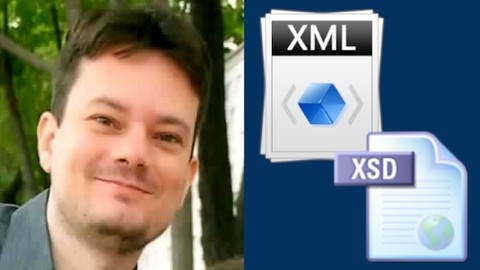XML (Extensible Markup Language) is a versatile markup language used to structure, store, and transport data.
It plays a crucial role in various applications, including web development, data exchange, and configuration files.
Learning XML empowers you to create well-formed documents, define data structures with schemas (like XSD), and manipulate data effectively.
By mastering XML, you’ll gain a valuable skillset applicable to diverse fields and industries.
Navigating the vast landscape of online courses to find the perfect XML course on Udemy can feel overwhelming.
You’re searching for a course that provides a solid foundation, covers essential concepts like XML Schema Definition (XSD), and offers practical examples to solidify your understanding.
The ideal course should cater to your learning style and equip you with the skills needed to confidently work with XML.
Our top recommendation for the best overall XML course on Udemy is XML and XML Schema Definition in Easy Steps.
This comprehensive course guides you through the fundamentals of XML, covering everything from basic syntax to advanced schema creation.
With practical exercises and real-world examples, you’ll develop a strong understanding of XML and its applications.
While this is our top pick, there are several other excellent XML courses available on Udemy that cater to different learning styles and specific needs.
Keep reading to discover a range of options that will help you embark on your XML learning journey.
XML and XML Schema Definition in Easy Steps
This course starts with the basics.
You’ll install Java and Eclipse, setting up your coding environment.
You’ll then learn how to use Github to manage and share your projects like a pro.
The course then dives into XML itself.
You’ll learn about its structure, elements, attributes, and how to create well-formed XML documents.
Practical examples, like building a driver’s license database, make learning fun and engaging.
Next, you’ll discover XML Schema Definition (XSD).
You’ll learn to define the structure and content of your XML documents, ensuring they are valid and error-free.
The course uses real-world examples, such as a patient management system, to help you grasp the concepts.
You’ll work with different XML schema types and learn to create complex schemas with restrictions, enumerations, and attribute types.
This course also covers XML parsing techniques using APIs like JAXP, DOM Parser, SAX Parser, and STAX Parser.
You’ll learn to choose the best parsing method for different situations.
The course provides hands-on experience, allowing you to write code and manipulate XML data using these powerful tools.
Finally, you’ll explore XSLT, learning how to transform XML documents into formats like HTML.
You’ll even get a quick introduction to DTD, an older but still relevant standard for defining XML document structure.
Learn XML Crash Course: Discover Essential XML Fundamentals
This XML crash course takes you from the fundamentals to more advanced techniques.
You begin with the basics, understanding what XML is and its importance.
You learn to create XML documents and use them effectively.
The course uses a hands-on approach, guiding you through demos, like creating a document type document, to solidify your understanding.
You even get demo files to practice alongside the lessons.
You then dive into advanced XML concepts.
You discover how to use attributes to add more information to your documents.
The course then introduces you to XML Schema, a powerful tool for defining the structure and content of your XML documents.
You continue learning with demos, exploring the use of namespaces in real-world scenarios.
Finally, you explore XSLT, a language used to transform XML data into other formats like HTML.
You learn how to use XSLT with XPATH, a language that lets you select specific parts of your XML documents.
This section concludes with a demonstration of how to present XML data clearly and shareably using XSL.
Learn XML-AJAX - For Beginners
This course starts by introducing you to the fundamentals of XML, including its basics, schema, and parsing techniques.
This lays a solid foundation for understanding how XML works and how to work with it effectively.
Once you’ve grasped the XML concepts, the course dives into AJAX, a powerful technique for creating dynamic and responsive web applications.
You’ll learn how to implement search suggestions and database-driven select menus using AJAX, giving you practical experience with this technology.
It also includes a hands-on development project that ties everything together.
You’ll set up a project from scratch, creating index, home, about, and blog pages.
Along the way, you’ll learn how to create a database, implement a registration form with JavaScript and AJAX validation, and build a secure login system with PHP.
The login authentication process is covered in-depth, spanning four separate lessons to ensure you understand every aspect of it.
You’ll also learn how to handle logout functionality and terminate user sessions properly.
Moving on, the course covers embedding maps on a contact page and integrating a contact form with AJAX.
You’ll install and use PHPMailer to handle email transmission from the contact form, ensuring your application can send emails reliably.
Finally, you’ll learn how to migrate your project to a production server, preparing it for deployment in a live environment.
Throughout the course, you’ll work with key technologies like Session management, PHPMailer, contact forms, login authentication, JavaScript, databases, XML, registration forms, logout functionality, production server migration, contact pages, PHP, and AJAX.
These practical skills will equip you to build robust and dynamic web applications using XML and AJAX.
Excel XML, XPath and XSLT Workflows
This course begins with the essentials of XML, getting you comfortable with its structure and key components like elements, attributes, and CDATA sections.
You will learn important concepts such as well-formed XML and how to validate it using DTDs and XML schema documents.
This foundation in XML prepares you for understanding its interaction with Excel.
You will then discover how to import and export XML data within Excel, create XML maps, and even import multiple tables from XML data.
You will master the WEBSERVICE function to retrieve data from external sources and harness the power of XPath to navigate and query XML data directly within Excel.
The course will also teach you how to use the FILTERXML function with ENCODEURL for handling URLs and the new CONCAT function for manipulating text within XML.
You will become comfortable with predicates for filtering data and the descendant-or-self axis for moving through XML documents.
Finally, you will explore XSLT stylesheets, a powerful tool for converting XML data into various formats.
You will learn to create new elements and attributes, use functions like xsl-copy-of, xsl-text, and xsl-value-of, and control the flow of your transformations with xsl-if and xsl:choose statements.
You will finish the course by mastering attribute value templates, a powerful technique for customizing the output of your XSLT transformations.
XML and XSD: a complete W3C-content based course (+10 hours)
This 10+ hour course provides a solid understanding of XML and XSD, teaching you how to structure your data effectively.
You’ll start with the basics of XML, learning its syntax and how to create well-formed documents.
You will then move on to explore different XML document types and learn how to validate them against a schema.
The course doesn’t stop at the basics.
You will dive into XSD (XML Schema Definition), learning how to create your own schemas and use them to validate XML documents.
You’ll become proficient in different XSD constraints, ensuring your data is consistent and accurate.
Through numerous hands-on exercises and real-world examples, you will gain practical skills in applying both XML and XSD.
This course prepares you for a deeper understanding of related technologies like WSDL and JSON, leading you towards web services development.
Building on your XML and XSD knowledge, you can confidently approach advanced concepts in web services, using languages like Java, Spring Boot, and Hibernate, popular choices in this domain.
You’ll find this course a valuable stepping stone to a career path dealing with structured data and web services.
XML - Begginer to Advance Crash Course
This XML course takes you from beginner to advanced, starting with the basics of what XML is and its significance in today’s digital world.
You learn by doing, creating your first XML document early on.
The course then guides you through understanding the structure of an XML document, particularly the XML tree and its role in data organization.
You then learn the rules of XML syntax, which are crucial for ensuring your documents are well-formed and valid, and explore XML elements and attributes, the building blocks of any XML document.
You learn how to define these elements and attributes to structure your data effectively.
The course delves into DTDs, which help you enforce rules and structure in your XML documents.
You learn about both internal and external DTDs, giving you a comprehensive understanding of how to manage document structure.
The course doesn’t stop at DTDs.
It introduces you to XML Schema, a more robust way to define the structure and content of your XML documents.
You discover why XML Schema is often preferred over DTDs and how to define your own schemas using XSD files.
You learn how to reference these XSD files in your XML documents and utilize schema attributes to add further refinement.
The course equips you with the knowledge to validate your XML documents, ensuring they adhere to the rules defined in your schemas.
XML Mastery: Unleashing the Power of Data Markup
You start with the basics, learning how to create and structure data using XML syntax.
You then move on to Document Type Definitions (DTDs) to validate your XML documents.
The course doesn’t neglect XML Schema Definition (XSD), providing a more robust method for defining XML structures.
You delve into XML processing, exploring parsers like DOM, SAX, and Stax.
You’ll use these to extract data from XML documents and manipulate it.
You discover the power of XSLT and XPointer, transforming and styling your data in various ways.
The course illustrates how XML integrates with web services and introduces you to XML-based technologies like SOAP.
You also discover how XML integrates with popular web development frameworks and technologies like AJAX, jQuery, and Java.
You’ll learn how to use XML alongside languages like JavaScript, HTML, CSS, and J2EE to create dynamic web applications.
This course provides a comprehensive understanding of how XML functions within a larger web development context.
Through practical examples like the “Schemas Examples” and “Document Object Model Examples”, you gain experience with XML concepts.
You’ll learn to create XML documents, validate them, and use stylesheets to format them.
The course covers advanced topics such as JAXB and XLink, illustrating their practical applications in XML development.
Learn XML From Scratch: Absolute beginner course
This course begins with the essentials of XML, teaching you what it is and how it works.
You will learn about the specific rules of writing XML, how to organize an XML document, and how to make your own custom tags.
You will also understand the role of whitespace, comments, and important elements like the XML declaration.
The course then demonstrates how to use Visual Studio Code to create and edit XML files.
You will learn how to install helpful XML extensions for Visual Studio Code, making writing XML code easier.
You will discover the structure of XML documents, how they are organized like a tree, and how to use XML schemas to define the structure and content of your data.
You will then explore how to work with XML data using XML processors and parsers, and how XML namespaces help organize XML data.
The course also teaches you how to use the XML Document Object Model (DOM) to access and work with XML data.
You will learn about CDATA sections, which are used to include special characters in your XML documents.
Finally, you will see real-world examples of how XML is used.
You will learn how to create and style your own XML documents and custom tags using CSS.








